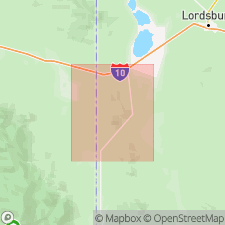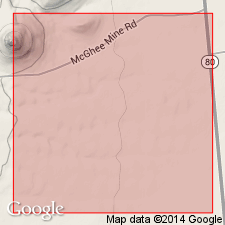
- Usage in publication:
-
- Bobcat Hill conglomerate
- Modifications:
-
- Original reference
- Dominant lithology:
-
- Sandstone
- Conglomerate
- AAPG geologic province:
-
- Pedregosa basin
Summary:
Pg. 55-58, table 1, pl. 1. Bobcat Hill conglomerate. Interbedded impure volcanic arkose sandstone and conglomerate. Conglomerate characterized by presence of fragments of limestone and volcanic rocks. Sandstones characteristically medium-bedded fine-grained light-grayish-green to yellowish-gray slightly calcareous. A 1-foot bed of limestone, which in places consists entirely of algal remains, occurs near base of formation in eastern part of outcrop area. Thickens from 724 feet in western part of area to 1,138 feet near North Star mines. Unconformably overlies unnamed volcanic rocks. Age is Cretaceous or Tertiary.
Named from exposures on north and west sides of Bobcat Hill, near corner common to secs. 25, 26, 35, and 36, T. 24 S., R. 21 W., Hidalgo Co., southwestern NM. Better exposed in S/2 sec. 27, in vicinity of North Star mines, and extends east and west across southern parts of secs. 26, 27, and 28, T. 24 S., R. 21 W., central Peloncillo Mountains, Hidalgo Co., southwestern NM.
Source: US geologic names lexicon (USGS Bull. 1200, p. 409).

- Usage in publication:
-
- Bobcat Hill Conglomerate
- Modifications:
-
- Age modified
- AAPG geologic province:
-
- Pedregosa basin
Summary:
Is a redbed sequence whose age is poorly constrained. Unconformably overlies Lower Cretaceous rocks. Mammal vertebra collected from upper volcaniclastic sandstone and conglomerate member of the Bobcat Hill Conglomerate on southeast slope of Bobcat Hill in the SE 1/4, SW 1/4, NW 1/4, NW 1/4 sec 36, T 24 S, R 21 W, Hidalgo Co., NM, Pedregosa basin. The specimen is about the size and is morphologically similar to posterior cervical vertebrae of late Eocene (Duchesnean-Chadronian) brontotheres. It is also the right size and morphology as a Chadronian entelodont. The oldest rocks that overlie the Bobcat Hill are no younger than early Oligocene. Measured section of upper member. May have been deposited as an early volcaniclastic apron deposit of the Mogollon-Datil volcanic field. Correlatable with rocks in the Rubio Peak Formation [Eocene, Oligocene, depending on author], or to lower part of Datil Group [Oligocene] on basis of age and lithology. [Age of lower part of Bobcat Hill not discussed.}
Source: GNU records (USGS DDS-6; Denver GNULEX).
For more information, please contact Nancy Stamm, Geologic Names Committee Secretary.
Asterisk (*) indicates published by U.S. Geological Survey authors.
"No current usage" (†) implies that a name has been abandoned or has fallen into disuse. Former usage and, if known, replacement name given in parentheses ( ).
Slash (/) indicates name conflicts with nomenclatural guidelines (CSN, 1933; ACSN, 1961, 1970; NACSN, 1983, 2005, 2021). May be explained within brackets ([ ]).

